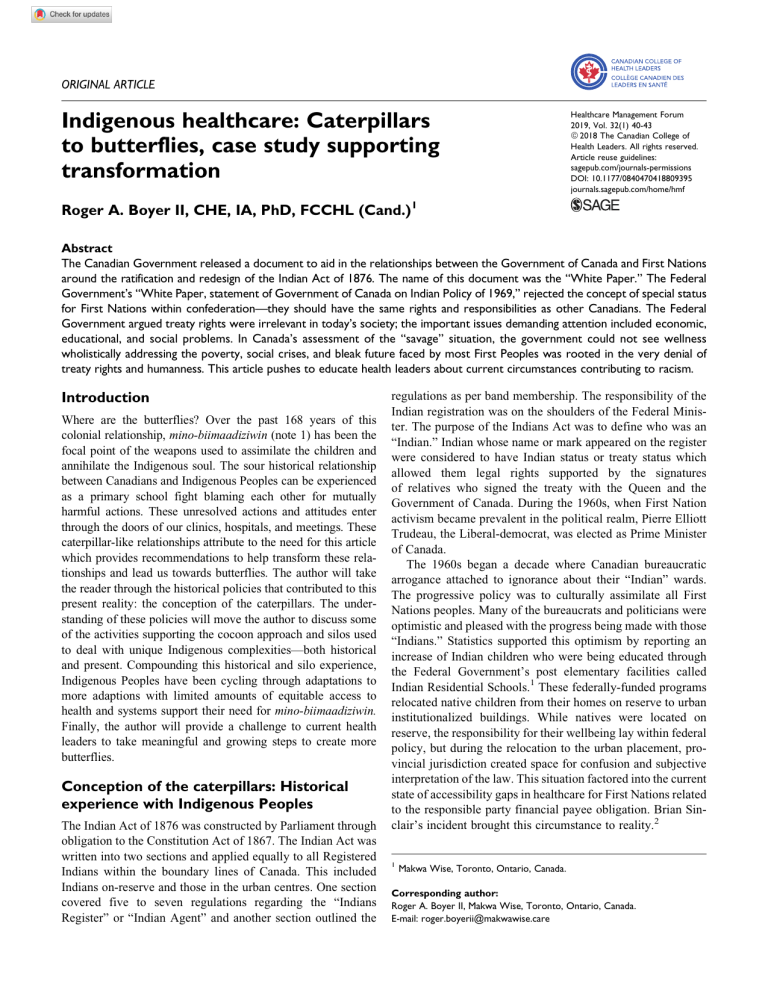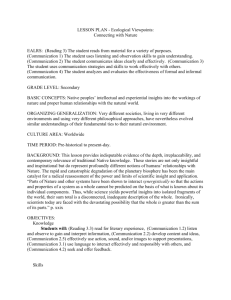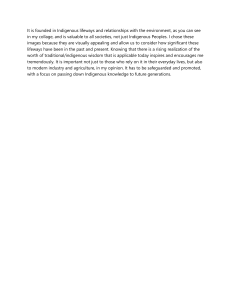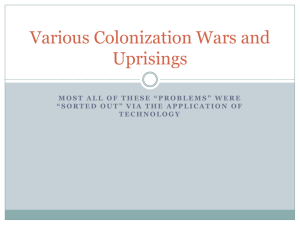
ORIGINAL ARTICLE Indigenous healthcare: Caterpillars to butterflies, case study supporting transformation Healthcare Management Forum 2019, Vol. 32(1) 40-43 ª 2018 The Canadian College of Health Leaders. All rights reserved. Article reuse guidelines: sagepub.com/journals-permissions DOI: 10.1177/0840470418809395 journals.sagepub.com/home/hmf Roger A. Boyer II, CHE, IA, PhD, FCCHL (Cand.)1 Abstract The Canadian Government released a document to aid in the relationships between the Government of Canada and First Nations around the ratification and redesign of the Indian Act of 1876. The name of this document was the “White Paper.” The Federal Government’s “White Paper, statement of Government of Canada on Indian Policy of 1969,” rejected the concept of special status for First Nations within confederation—they should have the same rights and responsibilities as other Canadians. The Federal Government argued treaty rights were irrelevant in today’s society; the important issues demanding attention included economic, educational, and social problems. In Canada’s assessment of the “savage” situation, the government could not see wellness wholistically addressing the poverty, social crises, and bleak future faced by most First Peoples was rooted in the very denial of treaty rights and humanness. This article pushes to educate health leaders about current circumstances contributing to racism. Introduction Where are the butterflies? Over the past 168 years of this colonial relationship, mino-biimaadiziwin (note 1) has been the focal point of the weapons used to assimilate the children and annihilate the Indigenous soul. The sour historical relationship between Canadians and Indigenous Peoples can be experienced as a primary school fight blaming each other for mutually harmful actions. These unresolved actions and attitudes enter through the doors of our clinics, hospitals, and meetings. These caterpillar-like relationships attribute to the need for this article which provides recommendations to help transform these relationships and lead us towards butterflies. The author will take the reader through the historical policies that contributed to this present reality: the conception of the caterpillars. The understanding of these policies will move the author to discuss some of the activities supporting the cocoon approach and silos used to deal with unique Indigenous complexities—both historical and present. Compounding this historical and silo experience, Indigenous Peoples have been cycling through adaptations to more adaptions with limited amounts of equitable access to health and systems support their need for mino-biimaadiziwin. Finally, the author will provide a challenge to current health leaders to take meaningful and growing steps to create more butterflies. Conception of the caterpillars: Historical experience with Indigenous Peoples The Indian Act of 1876 was constructed by Parliament through obligation to the Constitution Act of 1867. The Indian Act was written into two sections and applied equally to all Registered Indians within the boundary lines of Canada. This included Indians on-reserve and those in the urban centres. One section covered five to seven regulations regarding the “Indians Register” or “Indian Agent” and another section outlined the regulations as per band membership. The responsibility of the Indian registration was on the shoulders of the Federal Minister. The purpose of the Indians Act was to define who was an “Indian.” Indian whose name or mark appeared on the register were considered to have Indian status or treaty status which allowed them legal rights supported by the signatures of relatives who signed the treaty with the Queen and the Government of Canada. During the 1960s, when First Nation activism became prevalent in the political realm, Pierre Elliott Trudeau, the Liberal-democrat, was elected as Prime Minister of Canada. The 1960s began a decade where Canadian bureaucratic arrogance attached to ignorance about their “Indian” wards. The progressive policy was to culturally assimilate all First Nations peoples. Many of the bureaucrats and politicians were optimistic and pleased with the progress being made with those “Indians.” Statistics supported this optimism by reporting an increase of Indian children who were being educated through the Federal Government’s post elementary facilities called Indian Residential Schools.1 These federally-funded programs relocated native children from their homes on reserve to urban institutionalized buildings. While natives were located on reserve, the responsibility for their wellbeing lay within federal policy, but during the relocation to the urban placement, provincial jurisdiction created space for confusion and subjective interpretation of the law. This situation factored into the current state of accessibility gaps in healthcare for First Nations related to the responsible party financial payee obligation. Brian Sinclair’s incident brought this circumstance to reality.2 1 Makwa Wise, Toronto, Ontario, Canada. Corresponding author: Roger A. Boyer II, Makwa Wise, Toronto, Ontario, Canada. E-mail: roger.boyerii@makwawise.care Boyer On June 24, 1969, Jean Chrétien, Minister of the Department of Indian Affairs and Northern Development and future Prime Minister of Canada, collaborated with the Former Prime Minister of Canada; Pierre Trudeau3 released a document to aid in the relationships between the Government of Canada and First Nations around the ratification and redesign of the Indian Act of 1876. The name of this document was the “White Paper.” The Federal Government’s “White Paper,” rejected the concept of special status for native people within confederation—“they should have the same rights and responsibilities as other Canadians”. The Federal Government argued that Aboriginal and treaty rights were irrelevant in today’s society; the important issues demanding attention included economic, educational, and social problems. In their assessment of the native situation, the Federal Government could not see that the poverty, social crises, and bleak future faced by most First Peoples were rooted in the very denial of Aboriginal and treaty rights. In addition, it addressed provincial responsibility and called for the end of treaties. The Federal Government argued that this was the only way for First Nations to fully and equally participate in economic, political, and cultural life in Canada. The “White Paper” policy called for First Nation members to have no distinction from the general Canadian society. First Nations leaders rejected the “White Paper” for two irrevocable reasons: it did not address the problems plaguing the First Nations’ local communities, and the First Nations leaders, who represented the very people who would be most affected by its mandates, were not properly consulted regarding the details of this new policy.4 In November 1969, 144 delegates of the bands of British Columbia met at Kamloops Indian Residential School. This 5-day meeting allowed for the voices of the delegates to be heard by their represented leaders.5 Another aid to this counter attack came from the Union of BC Chiefs. This 39page document became foundational in the formation of Canadian legal terminology and ideology regarding First Nation policies. This policy’s focus was to “whitewash” culture, language, and identity from First Nations members across Canada allowing them to move from a “bad” life on the reserve, which was oppressive, to a “better” life among the anthropological “other” with unchanged feelings, emotions, beliefs, or negative consequence. The Government of Canada turned a deaf ear on the voice and worldview of these effected First Nations members regardless. Paul Hiebert explains, “Our worldview gives us emotional security . . . [and] our fundamental beliefs with emotional reinforcements so that they are not easily destroyed . . . provid[ing] psychological reassurance that the world is truly as we see it and a sense of peace.”6 The First Nations worldview has not been able to understand nor construct an assumption of peace because of the entire “brainwashing” event conducted by the Federal Government. The foundation of security and safety has never solidified. National Indian Brotherhood (NIB) was created behind the lines of war. The NIB reacted to “White Paper” policy in 1970. 41 The NIB, now known as the Assembly of First Nations, consisted of First Nations leaders and influential individuals of the time such as George Manuel, Walter Dieter, Noel Star blanket, Delbert Riley, Dr. David Ahenakew, Georges Erasmus, Ovide Mercredi, Phil Fontaine, and Matthew Coon Come. These leaders chose to present a counter policy to the “White Paper” calling it the “Red Paper.” This “Red Paper” policy, which was presented to Prime Minister Trudeau and his cabinet, was a counter attack which called for First Nations Treaty rights. The foundation for this argument laid in their beliefs that, “there is nothing more important than our treaties, our lands and the wellbeing of our future generations.” The NIB’s action against the legislation incited the First Nations community to take a renewed sense of pride in their heritage and culture. First Nations groups demonstrated that they could initiate positive action, form a united front of the nation, and successfully create political organizations from coast to coast. This marked the beginning of the First Nation movement and strong political activism. The following year in 1971, the Federal Government quietly put aside the “White Paper.” The controversial policy was silenced by the Supreme Court of Canada’s decision of Calder v Attorney General of British Columbia in 19737; however, native title was reaffirmed common law, and in response, the Federal Government took responsibility for the health and wellness of First Nations. Fast forward from these activities to the Canadian government under the leadership to Stephen Harper; he pushes for an apology for this trauma-filled past of Indigenous populations. This apology began the dialogue around reconciliation and healing both for Canadians and Indigenous leading to the need to know how to reconcile these relationships. This directional and need for guidance gave birth to the July 23, 2015, document entitled Honoring the Truth, Reconciling for the Future Summary of the Final Report of the Truth and Reconciliation Commission of Canada. This report explains that the Federal Government had never provided the funding and support needed to improve Indigenous health and wellbeing. There are 94 Calls to Action. These Calls to Action need to be reviewed by all health leaders and applied within their systems, structures, and cultures. The cocoon: Silos and struggle The “White Paper” was all about assimilation citizenship, and new white identity where as First Nations’ values consist of harmony, stewardship, and wholistic identity with Creator and Creation. The First Nation past experiences with the Government of Canada would support this incompatibility with any government policy with the words “assimilate” or “white”. These homogeneous acts to systems and structure are designed to help Canadians, but not Indigenous Peoples. This is called the “round peg into the square hole” approach to healthcare. This tug of war to make Indigenous Peoples conform to the silo approach of the Canadian health system demonstrates a lack of insight and innovation. There is a 42 jurisdictional black hole for Indigenous Peoples, the responsibility of healthcare being a federal or provincial responsibility and only recently resolved when five-year-old, Jordon River Anderson, died in a Winnipeg hospital while administrators were fighting about who was going to pay for the treatment. For further information about the Jordon’s Principle, please review Jordon’s Principle and Public Health (note 2). These imperial policies answer some of the needs but at a tremendous cost to the Indigenous. Each Nation lost their land, liberty, and law for education, citizenship, and employment causing great trauma. Within the western perspectives, those three elements would be an exchange for and fulfillment of some of the testing needs on the reserve but worldview points us back into the direction of connectedness with the land as paramount not only as a physical variable but also hold a spiritual ramification. These conflicting degrees of compatibility, this policy would be deemed an incompatible innovation. The Government of Canada committed the “empty vessel fallacy”8 by imposing a policy of freedom upon the First Nations. The Federal Government takes the First Nations for granted and continue to think we are an ill-legitimate child being passed back and forth by Canadian policies or procedures supporting Canadian superior education, and powerful ideas to continue the assimilation process of filling the blank slates of the First Nations’ mind. Due to this assumption, the compatibility of this innovation was quickly rejected by the First Nations. Nations are not seen as apart of the solution instead problem. This Indian problem persists today within our healthcare settings. The value system of the First Nations is unique and sacred because of its connectivity of wholistic spirituality. Limited models of healthcare support this intrinsic need. The increase rate of diffusion of the “White Paper” along communication channels continues to support this inequity of care across your home on native land. There is a real call for decisions and directions to be built on the worldview of First Nation decision-making of consensus. The opinions of First Nations leaders and collectivistic culture were able to come together from coast to coast and voice their reaction to this “White Paper.”9 This inclusive action is a start to investing into butterflies—real transformation. Investing in butterflies: Challenge to health leaders In a fiscally restrictive environment, investing in reconciliation seems to be far from the essential operational needs of your healthcare system, right? Reconciliation and its norms have the ability to transform not only your patient experience but empower your practitioners toward fulfillment. The health leadership challenges are to adopt or adapt a transformational leadership framework of reconciliation. The author will discuss this four-piece framework below. The majority of Canadian health leaders focus on two frameworks: LEAN or LEADS. The author’s critique of these starting point would be self-actualization, not service and Healthcare Management Forum support of staff and patients. To take this a step further, these streams lead to our focus as being performance and point achievement. These sterile, means to an end have pushed us into high rates of burnout and significant turnover in our middle to senior management positions. So, what is a solution? The author would like to suggest a transformative framework to leadership focused on empathy, authenticity, transparency, and CARE; or as the author coined the term E.A.T. CARE. This understanding is a transformation in leadership versus another measurement or target to achieve. One needs to be able to look in the mirror day-in and day-out to realize their staff are looking for someone to show them empathy to empower the impossible or miraculous. When this reality is achieved, authenticity and transparency support the evolution of CARE into all areas of the system including the water cooler conversations. So, I know you’re thinking, Roger, you have to give me more than this for a framework. However, this will not happen because in a world who seek the easy way or route from point A to B, the calling to this type of leadership will make you and take you to a co-creation of these values with your teams, families, and ultimately your patients spreading into the communities you call home. This is how you invest in butterflies: by not taking the easy way but the transformative way to co-creation of the E.A.T. CARE framework. So, the author challenges you to “get your Legos out” with your teams and start building your unique E.A.T. CARE Leadership framework interwoven with the values of your unique culture and community. Enjoy! Conclusion The author started this article with a question to the reader: where are the butterflies? The historical past of trauma, homogenization, and pure assimilation support the silos of the Indigenous relationship with Canada. The sour historical relationship between Canadians and Indigenous Peoples needs transformation from blaming each other to collaboration. These butterfly-like relationships will take a tremendous amount of mutual respect and risk. However, the author has challenged health leaders with a great framework of transformationalempathetic leadership entitled E.A.T. CARE which will provide the guide along this road less travelled in reconciling the trauma. The author would like to leave you with this thought: can we afford to not create a system to support the most traumaimpacted populations in order for mino-biimaadizwin, the good life, to be realized? The oaths of the healer, to do no harm, should be the foundation for all health systems. Notes 1. Mino-Biimaadiziwin is a conceptual reality to Indigenous, in particular Anishinabek, of the wholistic systems and structures an individual, families, and Nations connect to in order to live a good life on Mother Earth. This multifaceted norm is foundational to living the balanced Indigenous life. 2. https://www.cpha.ca/sites/default/files/uploads/policy/posi tionstatements/jordan-positionstatement-e.pdf. Boyer 43 References 1. Menno B. Surviving as Indians: The Challenge of Self-Government. Toronto, Ontario, Canada: University of Toronto Press; 1993:79. 2. Daniel NP. First Nations History: We Were Not the Savages: Collision between European and Native American Civilizations. 3rd ed. Halifax, Nova Scotia, Canada: Fernwood; 2006:264. 3. Pierre Trudeau Personal Web site. Available at: http://www.clever net.net/pierre_trudeau/. Accessed May 1, 2018. 4. Assembly of First Nations. Available at: http://www.afn.ca/article. asp?id¼59. Accessed April 30, 2018]. 5. Canada. Indian and Northern Affairs Canada. Statement of the Government of Canada on Indian Policy, 1969. Ottawa, 6. 7. 8. 9. Ontario, Canada: Indian and Northern Affairs Canada; 1969. No. R32-2469. Paul GH. Transforming Worldviews: An Anthropological Understanding of How People Change. Grand Rapids, MI: Baker Academic; 2008:29-30. Calder V. Attorney-General of British Columbia. Available at: www.library2.usask.ca/native/cnic/vol07/091.html. Accessed April 30, 2018. Everett MR. Diffusion of Innovations. 5th ed. New York, NY: Free Press; 2003:254. First Nations Governance Act moves Forward. INAC. Available at: http://www.aincinac.gc.ca/nr/prs/m-a2003/2-02324_e.html. Accessed May 21, 2018.


